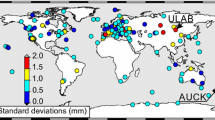Abstract
In the determination of the attitude parameters from a multi-antenna GPS array, one of the major assumptions is that the body frame is rigid at all times. If this assumption is not true then the derived attitude parameters will be in error. It is well known that in airborne platforms the wings often experience some displacement during flight, especially during periods of initializing maneouvres, such as taking off, landing, and banking. Often it is at these points in time that it is most critical to have the most precise attitude parameters.
There are a number of techniques available for the detection of modeling errors. The CUSUM algorithm has successfully been implemented in the past to detect small persistent changes. In this paper the authors investigate different methods of generating the residuals, to be tested by the CUSUM algorithm, in an effort to determine which technique is best suited for the detection of structural deformation of an airborne platform. The methods investigated include monitoring the mean of the residuals generated from the difference between the known body frame coordinates, and those calculated from the derived attitude parameters. The generated residuals are then passed to a CUSUM algorithm to detect any small persistent changes. An alternative method involves transforming the generated residuals into the frequency domain through the use of the Fast Fourier Transform. The CUSUM algorithm is then used to detect any frequency changes. The final technique investigated involves transforming the generated residuals using the Haar wavelet. The wavelet coefficients are then monitored by the CUSUM algorithm in order to detect any significant change to the rigidity of the body frame. Detecting structural deformation, and quantifying the degree of deformation, during flight will ensure that these effects can be removed from the system, thus ensuring the most precise and reliable attitude parameter solutions. This paper, through a series of simulations, will assess the effectiveness of the above mentioned techniques for detecting structural deformation effects on a GPS multi-antenna array. These principles are then tested with experimental data.
Similar content being viewed by others
References
Wahba G. A Least Squares Estimate of Spacecraft Attitude.SIAM Review, 1965,7(3): 409.
Lu G.Development of a GPS Multi-Antenna System for Attitude Determination [Ph D Thesis]. University of Calgary: Dept of Geomatics Engineering, Canada. 1995. 185.
Cohen C E, Parkinson B W, McNally B D. Flight Tests of Attitude Determination using GPS Compared Against an Inertial Navigation Unit.Navigation: Journal of the U.S. Institute of Navigation, 1994,41(1): 83–97.
Cannon M E, H Sun, T Owen,et al. Assessment of a Non-Dedicated GPS Receiver System for Precise Airborne Attitude Determination.7th Int Tech Meeting of the Satellite Division of the U S Inst of Navigation. Salt Lake City, Utah 20–23 September, 1994. 645–654.
Tsujji T.Precise Determination of Aircraft Position and Attitude Using GPS Carrier Phase Measurement, [Ph.D Thesis]. Kyoto University: Dept of Applied Mathematics & Physics, Japan. 1998.
Mertikas S P. Automatic and on-Line Detection of Small But Persistent Shifts in GPS Data and Statistical Process Control.GPS Solutions, 2001,5: 39–50.
Wickerhauser M.Adapted Wavelet Analysis from Theory to Software. Wellesley, Mass: AK Peters Ltd, 1994. 486.
Daubechies I. The Wavelet Transform, Time-Frequency Localization and Signal Analysis.IEEE trans IT, 1990,36(5): 961–1995.
Reza A. From Fourier Transform to Wavelet Transform. http://www.xilinx.com, 1999.
Satirapod C, Ogaja C, Wang J. An Approach to GPS Analysis Incorporating Wavelet Decomposition.Artificial Satellites, 2001,36(2): 27–35.
Author information
Authors and Affiliations
Corresponding author
Additional information
Biography: M. J. Moore (1975-),male, Ph.D candidate, Bgeomatics & BSc, research direction: attitude determination.
Rights and permissions
About this article
Cite this article
Moore, M.J., Rizos, C. & Wang, J. The detection of structural deformation errors in attitude determination. Wuhan Univ. J. Nat. Sci. 8, 677–684 (2003). https://doi.org/10.1007/BF02899834
Received:
Issue Date:
DOI: https://doi.org/10.1007/BF02899834




